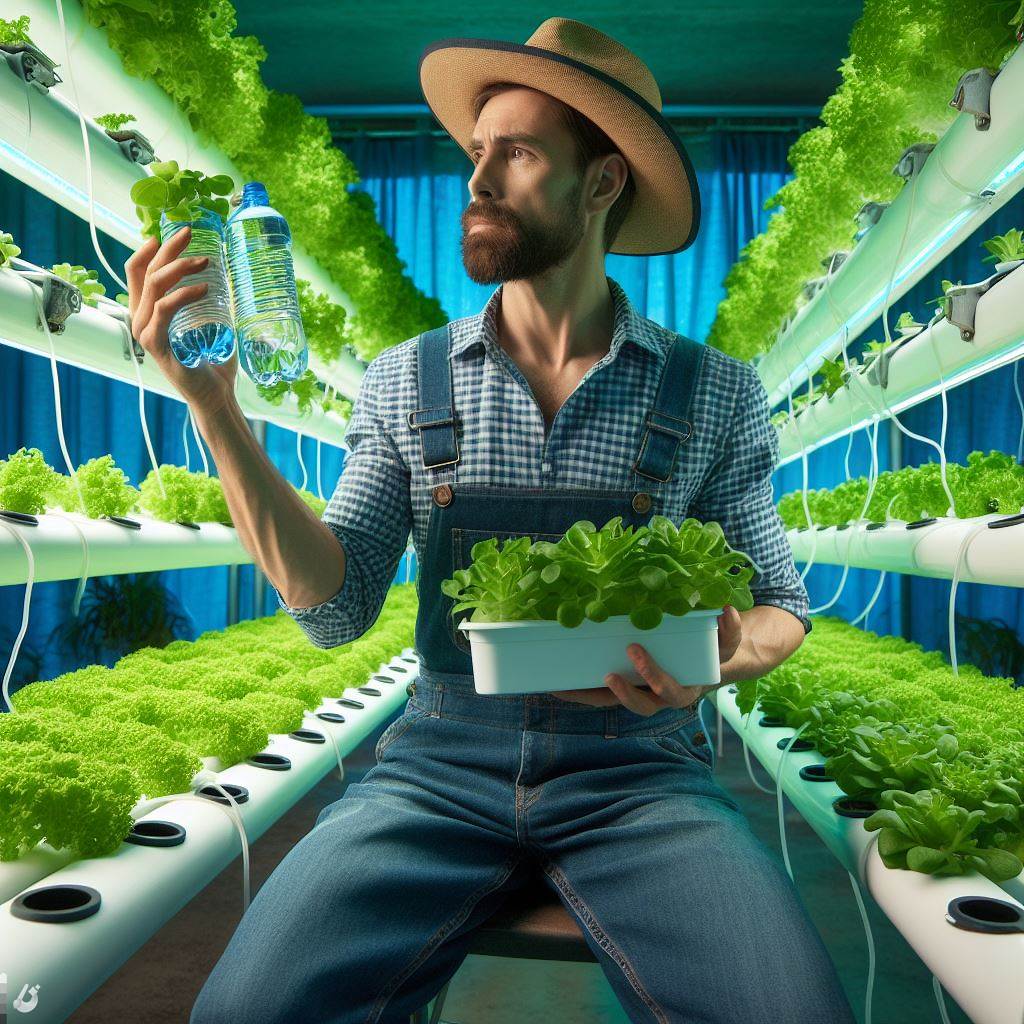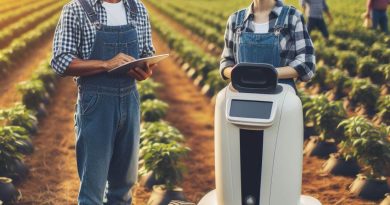Hydroponics 101: Basics & Benefits
Last Updated on January 18, 2024
Introduction
Hydroponics is emerging as a smart farming technique that does not require soil and leverages nutrient-rich water solutions to grow plants.
With the world’s population estimated to reach 10 billion by 2050, innovative farming methods like hydroponics are critical for meeting global food demands.
This blog post will provide an introductory overview of hydroponics, its benefits, and why it is important for the future of agriculture.
Hydroponics is a method of growing plants without soil by delivering nutrients directly to the roots via a nutrient-rich aqueous solution.
Plants are supported using various inert growing mediums like perlite, clay pebbles or coconut coir instead of soil.
This allows the precise control of nutrients that each plant needs for optimal growth.
Hydroponic systems enable substantially higher yields compared to conventional soil-based farming.
Plants grow up to 50% faster as the roots directly access nutrients and do not have to forage through soil.
Hydroponics also conserves up to 90% more water compared to soil farming since the nutrient solutions can be recirculated and reused.
With benefits like faster growth, higher yields, less water usage and the ability to grow crops year-round, hydroponics is poised to transform modern agriculture.
As global populations grow, innovative solutions like hydroponics will be key to meeting rising food demands in a sustainable manner.
What is Hydroponics?
Hydroponics is a revolutionary method of growing plants without soil using nutrient-rich water solutions.
There are several different methods of hydroponics, each with its unique approach to nourishing plants:
- Nutrient Film Technique (NFT): This method involves a continuous flow of nutrient-rich water that runs along a sloped trough, allowing plant roots to absorb the necessary nutrients.
- Deep Water Culture (DWC): In this method, plants are suspended in a nutrient-rich solution with their roots submerged in water.
- Drip System: This hydroponic method involves using a timer-controlled dripper that releases nutrient solutions directly onto the plants’ roots.
- Aeroponics: Aeroponics is a high-tech hydroponic system where plant roots are suspended in the air and misted with nutrient solutions.
- Wick System: In this straightforward method, a wick transports nutrients from a reservoir to the plants’ roots.
Advantages of Hydroponics
Hydroponics offers numerous advantages over traditional soil-based farming, making it increasingly popular among modern farmers:
- Water Efficiency: Hydroponics uses up to 90% less water compared to traditional farming, making it an eco-friendly solution.
- Space Utilization: This method allows for vertical and indoor farming, making it feasible for urban areas or limited spaces.
- Higher Yields: Hydroponically grown plants often have higher yields than traditional methods due to optimized nutrient availability and controlled environmental conditions.
- No Soil Dependency: Hydroponics eliminates the need for fertile soil, making it suitable for areas with poor soil quality or contaminated land.
- Pest and Disease Control: Since hydroponic systems are soil-free, the risk of pests, weeds, and soil-borne diseases is significantly reduced.
- Year-Round Harvests: With hydroponics, farmers have greater control over growing conditions, enabling them to grow crops throughout the year regardless of season or climate.
- Enhanced Nutritional Value: By providing plants with precise nutrient solutions, hydroponics allows for the production of nutrient-rich and flavorful crops.
- Reduced Labor: Automated systems and precise nutrient delivery in hydroponics reduce the need for manual labor, saving time and effort.
Essentially, hydroponics is a groundbreaking method of plant cultivation that relies on nutrient-rich water solutions instead of soil.
With various techniques available, farmers can choose the most suitable hydroponic system according to their needs.
The numerous advantages, such as water efficiency, higher yields, and year-round harvests, make hydroponics an attractive alternative to traditional farming methods.
By embracing hydroponics, we can revolutionize agriculture and create a more sustainable and productive future.
Read: Agri Robots: The Future of Farming Now
Setting Up a Hydroponic System
Listed below are the essential steps and factors to consider when setting up a hydroponic system for optimal plant growth:
Selection of Suitable Containers for the Hydroponic System
When choosing containers for your hydroponic system, it is important to consider factors such as durability, size, and material.
Containers can range from small buckets to large tanks, depending on the scale of your operation.
Choosing the Right Growing Medium for Plants
In hydroponics, the growing medium serves as a support system for the plants’ roots.
It should provide stability, good drainage, and proper aeration.
Examples of popular growing mediums include perlite, coco coir, and vermiculite.
Essential Components of a Hydroponic System
A hydroponic system requires various components to function properly.
These include pumps to circulate the nutrient solution, reservoirs to store and distribute the solution, and grow lights to provide the necessary light spectrum for plant photosynthesis.
Factors to Consider for Optimal Plant Growth
To ensure optimal plant growth, it is crucial to monitor and maintain certain factors within the hydroponic system. These include:
- Temperature: Most plants thrive in temperatures between 65°F-80°F (18°C-27°C). Maintaining a stable temperature is essential for plant health.
- pH Level: The pH level of the nutrient solution directly affects nutrient availability to the plants. Maintaining a pH level between 5.5-6.5 is generally ideal for hydroponic systems.
- Nutrient Solution: Hydroponic plants rely on nutrient-rich solutions for their growth. It is important to provide a well-balanced nutrient solution that includes essential macro and micronutrients.
- Oxygen Levels: Plants require oxygen for their roots to function properly. Oxygenation systems, such as air pumps and airstones, should be incorporated into the hydroponic system to ensure adequate oxygen levels.
- Light Intensity: Proper lighting is essential for photosynthesis and overall plant growth. Different plants require different light intensities, so it is important to choose the appropriate grow lights for your specific plant species.
- Timers and Automation: Implementing timers and automation systems can help regulate the hydroponic system’s functions, such as nutrient distribution, lighting schedules, and water circulation.
By considering these factors and following the proper steps, you can successfully set up a hydroponic system that provides an ideal environment for plant growth and maximizes your yields.
Read: Solar-Powered Irrigation: A Deep Dive
Benefits of Hydroponics
There are numerous benefits to utilizing hydroponics as a method of farming.
From efficiency to sustainability, hydroponics offers several advantages over traditional soil-based agriculture.
Efficient use of space with vertical farming techniques
One of the biggest advantages of hydroponics is the ability to maximize space utilization.
With vertical farming techniques, plants can be grown in layers, allowing for multiple crops to be grown in a smaller area.
Conservation of water resources through recirculating systems
Hydroponics uses a recirculating system that allows for the conservation of water resources.
Unlike traditional farming, which can be water-intensive, hydroponics recirculates water, minimizing wastage and preserving this precious resource.
Reduced use of pesticides and herbicides in hydroponics
Another significant advantage of hydroponics is the reduced need for pesticides and herbicides.
Because the plants are grown in a controlled environment, the risk of pests and weeds is significantly minimized, resulting in a decrease in chemical usage.
Year-round crop production and elimination of seasonal constraints
Hydroponics allows for year-round crop production, eliminating the limitations that come with seasonal farming.
By providing a controlled environment, hydroponics enables farmers to grow crops regardless of the time of year or external climate conditions.
Enhanced nutrient uptake and faster plant growth
Plants grown hydroponically have access to a highly optimized nutrient solution, resulting in enhanced nutrient uptake.
This allows for faster plant growth and ultimately higher crop yields compared to traditional soil-based farming.
In essence, hydroponics offers several compelling benefits that make it an attractive alternative to traditional agriculture.
From its efficient use of space and water resources to its reduced need for pesticides and herbicides, hydroponics proves to be a sustainable and innovative farming method.
Not only does it allow for year-round crop production, but it also enables faster plant growth through enhanced nutrient uptake.
With these advantages, hydroponics has the potential to revolutionize the way we approach farming and food production.
Read: Sustainable Farming via Tech Innovations
Common Challenges in Hydroponics
Hydroponics, although advantageous in many aspects, is not without its challenges.
To ensure successful hydroponic gardening, it is essential to be aware of and overcome these common issues:
Potential issues with nutrient balance
- Inadequate nutrient levels can lead to nutrient deficiencies in plants, affecting their growth and development.
- Excessive nutrient levels can cause nutrient toxicity, leading to plant damage or death.
- Regular monitoring of nutrient levels and adjustment is crucial to maintain a proper balance.
Maintaining proper pH levels in the nutrient solution
- Incorrect pH levels can hinder nutrient uptake, affecting plant growth and overall health.
- The optimal pH range for most hydroponic crops is between 5.5 and 6.5.
- Regular testing and adjusting the pH of the nutrient solution is necessary to ensure proper nutrient availability.
Preventing root rot and other diseases in a hydroponic system
- Stagnant water or excessive moisture can promote the growth of harmful microorganisms, leading to root rot.
- Using a well-draining growing medium and maintaining proper oxygen levels in the root zone can prevent root rot.
- Regular sanitization of the hydroponic system and careful monitoring can help prevent the spread of diseases.
Continuous monitoring and troubleshooting for optimal plant health
- Regular observations of plant growth, water quality, and nutrient levels are essential for early detection of issues.
- Identifying and promptly addressing any problems, such as nutrient imbalances or pest infestations, is crucial for optimal plant health.
- Implementing a systematic approach to troubleshooting can help identify and resolve issues efficiently.
Despite these challenges, hydroponics offers numerous benefits that make it a popular choice among gardeners.
By being aware of these potential issues and actively addressing them, hydroponic enthusiasts can enjoy successful and thriving crops.
Read: Automated Farming: Pros & Cons Explored

Examples of Successful Hydroponic Systems and Applications
Hydroponics has gained popularity in recent years due to its numerous benefits and the ability to grow crops in a controlled environment.
Let’s take a look at some successful hydroponic farms and their methods, specific crops that thrive in hydroponic systems, and examples of urban gardening and community hydroponic projects.
Successful hydroponic farms and their methods
- Vertical Harvest in Jackson, Wyoming, is a three-story hydroponic greenhouse that produces vegetables year-round.
- They utilize a nutrient film technique (NFT) system where a thin film of nutrient-rich water constantly flows over the plant roots.
- The Farmery, founded in North Carolina, combines hydroponics with aquaculture by growing vegetables and fish together.
- They employ a deep-water culture (DWC) system where plant roots are immersed in oxygenated nutrient water.
- Urban Organics in St. Paul, Minnesota, is an indoor hydroponic farm located in a former brewery.
- They employ a nutrient solution system (NSS) where plants are grown in water supplemented with essential nutrients.
Specific crops that thrive in hydroponic systems
- Leafy Greens: Lettuce, spinach, kale, and Swiss chard grow exceptionally well in hydroponic setups due to their shallow root systems.
- Herbs: Basil, mint, cilantro, and parsley are popular herbs that flourish in hydroponics due to their high demand and fast growth.
- Strawberries: Hydroponic strawberries are known for their vibrant flavors and larger yields compared to soil-grown strawberries.
- Tomatoes: This popular fruiting crop can be successfully cultivated in hydroponic systems, producing flavorful and bountiful harvests.
- Cucumbers: The vertical growth habit of cucumbers makes them ideal for hydroponic cultivation, optimizing space utilization.
Examples of urban gardening and community hydroponic projects
- The Gotham Greens rooftop greenhouse in Brooklyn, New York, supplies the local community with hydroponically-grown fresh produce.
- In Singapore, the Sky Greens vertical farm uses rotating towers to grow vegetables in urban environments, minimizing land use.
- The Plantagon in Linköping, Sweden, is a multi-story greenhouse that integrates hydroponics and vertical farming in a symbiotic system.
- Many schools and educational institutions have started hydroponic projects to teach students about sustainable agriculture and healthy eating.
- Community gardens worldwide are embracing hydroponics as a means to grow food locally and increase self-sufficiency.
These examples demonstrate the versatility and success of hydroponic systems.
Whether it’s large-scale commercial farms, home gardens, or community projects, hydroponics offers an efficient and sustainable method of growing crops.
Conclusion
Key points discussed in the blog post
In this blog post, we covered the basics of hydroponics and highlighted its numerous benefits.
Hydroponics offers a sustainable farming solution by conserving water and maximizing plant growth.
It eliminates the need for soil, making it perfect for urban environments.
To recap, we discussed the different types of hydroponic systems, including nutrient film technique and deep water culture.
We also explored the advantages hydroponics has over traditional soil-based farming, such as faster growth, higher yields, and reduced pests.
Summary of the benefits and potential of hydroponics
The potential of hydroponics is immense.
It can revolutionize agriculture by allowing farmers to grow crops in any climate or season.
Additionally, hydroponics can be used to produce food in areas with limited access to arable land or areas affected by soil contamination.
Encouragement for readers to explore hydroponics for sustainable farming
We strongly encourage our readers to explore hydroponics and consider it as an option for sustainable farming.
By adopting this method, we can contribute to a greener future and alleviate pressure on traditional farming practices.
Join the hydroponic community and discover the endless possibilities of this innovative growing technique.
Start small-scale experiments or research local hydroponic farms.
Whether you are a seasoned farmer or a curious beginner, hydroponics offers an exciting path towards sustainable and efficient agriculture.
Let’s embrace this technology and nourish our planet for generations to come.


